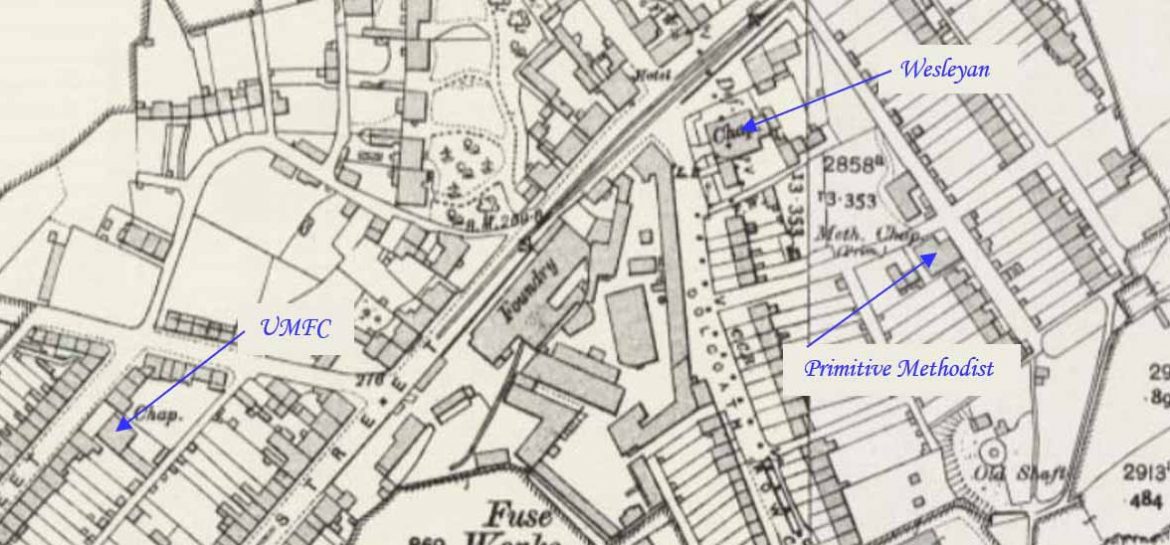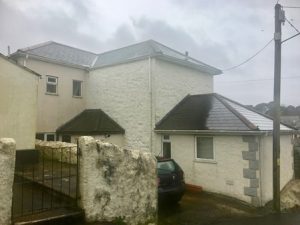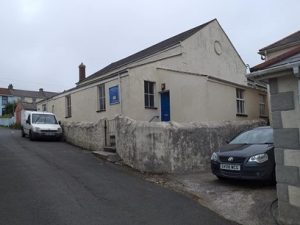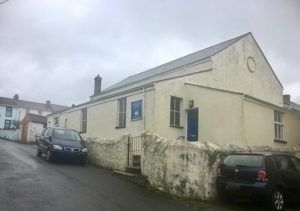Mapping Methodism – Tuckingmill Primitive Methodist Chapel
Categories Mapping Methodism, Projects0 Comments
Tuckingmill is a village in the civil parish of Camborne. This profile of Tuckingmill Primitive Methodist Chapel has been compiled by Jo Lewis and Tony Mansell.
The forecourt walls of a former Primitive Methodist chapel, built in c1871 survive at this location in Tuckingmill. It is recorded on the 1st and 2nd Editions of the 1:2500 OS maps c1880 and c1907. Mostly render on rubble walls; asbestos slate roofs replacing probable scantle slate. Simple gable-ended building with front side and entrance wall now obscured by later C20 Sunday school lean-to extension. Much altered now a Christadelphian Hall. (Cornwall Heritage Gateway)
Primitive Methodist Meeting Hall
 (Photo: Jo Lewis)
(Photo: Jo Lewis)
Originally the meeting place, this building is next door to the Primitive Methodist Chapel on Primitive Row. In 1849 a Joel Blamey (a Bible Christian convert and once leader at the Blowinghouse / Grennifer Chapel…now lost) moved to Tuckingmill on the closure of Blowinghouse Chapel. By 1859 there was certainly a congregation of Primitive Methodists meeting at Tuckingmill. It is thought that Primitive House, close to the chapel (see next) was likely an early meeting hall for the society. It was succeeded by the 1863 chapel and later became a Mine Captains house.
1863 Primitive Methodist Chapel
Located in Primitive Row / Hill, it sits behind the former Wesleyan Chapel. This Primitive Methodist Chapel is currently used as a Christadelphian meeting place.


“Tuckingmill’s third chapel, which still stands today and is used as a Christadelphian meeting place, was its Primitive Methodist chapel. Its name is perpetuated in the local street names of Primitive Row and more recently Primitive Hill. Primitive House, now a private residence, also stands close by and is believed to have been an early meeting hall for the Society.
The Primitive Methodists were another breakaway group from the mainline Wesleyans in the early nineteenth century and their work mainly focused amongst the poorer classes in society and especially in industrialised communities. Their origins go back to the outdoor ‘Camp Meetings’ which took place at such places as the Mow Cop in Staffordshire on 31 May 1807 which focused on outdoor evangelistic preaching and prayer meetings, disapproved of by the much more socially and politically conservative Wesleyans. They believed in what they regarded as purer and more ‘primitive’ forms of worship and religious expression, more akin to what in their opinion would have been coterminous with the ideals of John Wesley, who had died in 1791. If you like it was a back to basics, no frills, lay led, working class movement. In their very early days, for example, they disapproved of organs in chapels, as did another group called the Protestant Methodists who also seceded from the Wesleyans in 1827.
We know that by 1859 there was certainly a congregation of Primitive Methodists meeting at Tuckingmill and in 1863 the new chapel was opened at a cost of £211 10 shillings. It provided seating accommodation for 200 people. An early stalwart of this Society was a man called Joel Blamey, who had come to Tuckingmill upon the closure of a chapel at Grenifer in Illogan, while another person who later had involvement as a Class Leader, organist, Sunday School Superintendent, Society Steward and Treasurer was a Charles May. The chapel had about an eighty-year life of existence with various sources giving a closure date of between 1937 and 1941. Upon closure the pulpit bible was given to Mr W C Perry and its hymnbook to Mr R Rowe.
After closure the chapel became for a number of years the meeting place of the St Luke’s Lodge of Freemasons and subsequently the Christadelphian Church.
I don’t have any early images of this chapel in my collection but the first photograph below was taken last week and shows the building as it is in 2020. You will notice in the gable end of the chapel a roundel, which today is blank. Originally this would probably have contained within it the letters PMC, for Primitive Methodist Chapel, and the building date of 1863.
I was given the second photograph below well over thirty years ago and this is the only known picture of the chapel interior with its new organ, towering over what is an uncompromisingly plain wooden pulpit, very different from some of the more ornate pulpits and rostrums found in Cornish Wesleyan and Free Methodist chapels. I was told by the donor of the picture that the man sat by the organ was a Mr Fleetwood. Newspaper research has revealed that the new organ for the Tuckingmill Primitive Chapel was opened on Thursday 1st February 1923 by the Revd W A Bryant, the local Primitive Methodist Minister. It possessed only one manual and had eight stops, costing £275 to build.”
Charles Mitchell Fleetwood, a native of Bath and who had worked for the Sweetland organ building firm in that city, until he set up his own organ building business in Carnarthen Row in Camborne around 1882, had himself died in 1893. His older son Augustus John (known as Gussie) who had carried on the firm with his brother, had himself died in 1921, so it cannot be him in the photograph. If it is indeed a Mr Fleetwood in the picture then it could only be Charles Mitchell Fleetwood’s younger son Ernest Charles.
The Fleetwood firm’s first known organ was the vanished one at the former Roseworthy Wesleyan chapel, supplied in 1884, while the oldest known surviving example is the instrument still in use at Mount Hawke Methodist Church, dating from 1885. The last Fleetwood of Camborne built pipe organ was this one for Tuckingmill Primitive Chapel in 1923. It is an historic image. The firm was in business therefore for about four decades and a large amount of its business was the provision, tuning and maintenance of the pipe organs for the plethora of local Methodist chapels, a part of Camborne’s vanished industrial and little-known past.
(Acknowledgement is very gratefully made to David Cracknell’s ‘My Primitive Methodists’ online website for some of the above information about the chapel building). (David Thomas)
 (Photo: Jo Lewis)
(Photo: Jo Lewis)
25 Nov 1863: Lease, land for new Primitive Methodist Chapel, Tuckingmill, Illogan. Parties: 1) John Henry Hippisley esquire, Shobrooke Park, Devon; Honourable Percy Moreton, Tortworth Court, Gloucester and Edmund Chase Marriott esquire, Adlestrop House, Oxford. 2) John Francis Basset esquire, Tehidy Park, Camborne. 3) Matthew Quintrell, gardener, Camborne. Piece of land at Tuckingmill in Illogan being eleven and a half perches, bounded on northeast with road, on southeast with wall to be built on southwest with John William’s plot and northwest with road adjacent to John Trestain’s premises. Term: 99 year lease being the lives of Josiah Willey Pengelly son of Samuel Pengelly, carpenter, Tuckingmill; Samuel Trythall son of Francis Trythall, miner, Beacon, Camborne; Joseph Teague son of William Teague, mine captain, Tincroft Mine, Illogan. Rent: 11 shillings and 9 pence. Consideration: lessee in two years to build good and substantial stone built chapel with slated roof and proper offices and outbuildings, to spend at least £100.Plan on dorse. (Kresen Kernow MRCB/258)
1863: Build date. (SWChurches)
1863: The new chapel opened
Seating accommodation for 200 people.
The chapel cost £211/10/0 to build.
It is surrounded by mining houses, which sit immediately below the South Crofty mine, adjacent to the hill Charles Wesley was driven down out of Illogan Parish, now known as East Hill.
25 Apr 1868: Assignment of lease, Tuckingmill Primitive Methodist Chapel, Illogan. Parties: 1) Matthew Quintrell, gardener, Camborne. 2) John Parry Bellingham, superintendent preacher of district. 3) John Nicholls, iron founder, William Richards, grocer, John Hosking, agent, Edward Smith, draper, all of Redruth and Francis Trythall, miner, William Bryant, miner and William Reynolds, sawyer, all of Camborne, trustees. Plot of land in Tuckingmill, Illogan with Chapel built thereon. Recites: lease of 1863. Consideration: £5 to be paid out of money in hands of trustees of Primitive Methodist Connexion. Attached: note of lives on original lease, ‘all three are living still’, 1900. (Kresen Kernow MRCB/259)
1899: “Tuckingmill Primitive Methodists intend shortly to renovate their building. It will be enlarged, made longer, and otherwise improved the energetic Protestants. We wish them success in their laudable efforts, which will place them on equal footing with others of their confreres in the circuit.” (Cornubian and Redruth Times – Friday 24 November 1899)
1900: Chapel rebuilt. (SWChurches)
1922: New organ installed.
1937 and 1941: Closure at some time between these dates, last archived minutes are up to 1941.
1941: Closure date according to David Easton, Methodist Minister and historian.
Following closure the chapel became for a number of years the meeting place of the St Luke’s Lodge of Freemasons.
Subsequently used by the Christadelphian Church. (David Easton, Methodist Minister and historian)
